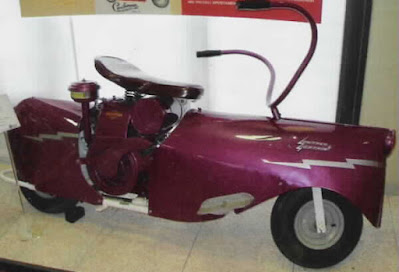Indian Scoot Today we will return to discussing about the scooters. Well, the two-wheeled vehicle mode could be said the transitional vehicle product that usually had become one of the options for the automotive industry players in facing the world's economic downturn that occurred shortly after the 2nd World War ended.
 |
| 1949 Indian Stylemaster posed along with another American-made scooter, 1948 Salsbury Model 85 in the museum. (Picture from: Motoredbikes) |
Reportedly, the scooter was started from the unique formed two-wheeled vehicle vehicle named the Autoped firstly invented by Arthur Gibson in Long Island back in 1916, it later developed into a trend for decades all over the world following the success of two Italian manufacturers, Innocenti and Piaggio through their legendary scooter brands (Lambretta and Vespa).
Meanwhile in America, which is the birthplace of scooters, many scooter manufacturers have also emerged at that time, including those whom are well-known and have long been known in the manufacture of ordinary motorcycles. It was recorded in history that famous American motorcycle manufacturers such as Harley-Davidson also had produced scooter in 1960 named Harley-Davidson Topper.
 |
| 1949 Indian Stylemaster is powered by 6 horsepower Briggs and Stratton engine. (Picture from: Bonham) |
But not many know that long before the Milwauke-based motorcycle maker produced a scooter, it turned out there's another American motorcycle manufacturer, Indian Motorcycle had ever produced scooter model named Indian Stylemaster back in 1949 (some said that's only reached up to prototype and never produced). Indeed, there is very little information related to scooters made by Indian Motorcycle in the past.
It began shortly after World War II ended, Indian Motorcycle was in deep trouble, their dealer network was deteriorated, their factory equipment was outdated, not to mention many other things continued to suck the life blood of a once prosperous company. Peak in 1949, they should killed their famous Indian Chief models and replaced it with a series of small vertical single cylinder and twin cylinder motorcycles.
 |
| 1949 Lowther Lightnin known as one of the world's rarest two-wheeled vehicles and probably taken as the base of the Indian Stylemaster scooter made by Lowther Manufacturing Co. (Picture from: VespaForever) |
And to solve these problems, the management of the company based in Spirit Lake, Iowa then contracted Lowther Manufacturing Co. of Joliet, Illinois to produce a series of small motor scooters.
At that time the company was known to produce several types of small motorcycles or scooters, and the most famous ones was the Lowther Lightnin', possibility it was then used as the basis for a new scooter to fulfill its contract with Indian Motorcycle.
 |
| At the time the Indian Stylemaster scooter was selling poorly despite being advertised as 'America's Most Modern Motor Scooter'. (Picture from: Bike-Urious) |
As quoted of Bonham, at that time around 24 scooter variants were offered but it's possible that only 3 models were successfully marketed, namely the Spartan, Vagabond, and the futuristic Stylemaster.
The Indian Stylemaster is powered by 6 horsepower Briggs and Stratton engine, at the time the scooter was selling poorly despite being advertised as 'America's Most Modern Motor Scooter,' and is hardly seen it again nowadays. The scooter has a fairly unique shape featuring front and rear fenders, magneto ignition, a jiffy stand, a locking key ignition, front and rear safety guards, 2-passenger seat, and engine air scoop and a sparkling chrome headlight.
The Stylemaster production (as well as the partnership with Lowther) was discontinued after run only one year and today about 18 units of the Indian Stylemaster scooter had survived. And the scooter finished in black and brilliant red has been part of a private collection for 5 years, and also is claimed to be museum quality.
 No idea if that means it’s only cosmetically perfect, or if it’s capable of running, as well. The seller claims that this is only one of two known Stylemasters in the United States, but we’re having trouble verifying that notion. Whether or not it’s 1 of 2, it’s still definitely a rare scooter and had been sold at Bonham's auction back in 2009 with the price of $10,530.
No idea if that means it’s only cosmetically perfect, or if it’s capable of running, as well. The seller claims that this is only one of two known Stylemasters in the United States, but we’re having trouble verifying that notion. Whether or not it’s 1 of 2, it’s still definitely a rare scooter and had been sold at Bonham's auction back in 2009 with the price of $10,530.Kept spur your adrenaline on the power of the two-wheeled monster and
stay alive with true safety riding. May God will forgive Your sins and
so does the cops...... *** [EKA | FROM VARIOUS SOURCES | INDIAN MOTORCYCLE | BIKE-URIOUS | BONHAM ]
Note: This blog can be accessed via your smart phone.

































